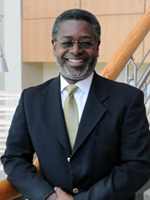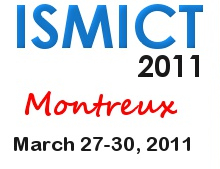Go to
Anthony Guiseppi-Elie
 Dow Chemical Professor
Dow Chemical Professor
Director; Center for Bioelectronics, Biosensors, and Biochips
Department of Chemical and Biomolecular Engineering
Department of Bioengineering
Department of Electrical and Computer Engineering
Clemson University, Clemson, S.C., USA
An Implantable Biochip to Influence Patient Outcomes Following Trauma-induced Hemorrhage
Silicon's intersection with biology is a premise inherent in Moore’s prediction. However, to realize this prediction, two grand challenge problems must be addressed - the long term biocompatibility of synthetic materials within the human body and the successful interfacing of solid state micro- and nano-electronic devices with the electronics of biological systems. Our center has concerned itself with these two grand challenge issues. We have sought to address these challenges through the exampled development of an implantable biochip for the measurement of key biomarkers of physiological stress during trauma induced hemorrhage [1]. Trauma induced hemorrhage is accompanied by hyperlactatemia, lacticacidosis and hyperglycemia, with continuously elevated levels of lactate and glucose leading to extensive tissue damage, septicemia and multiple organ dysfunction syndrome (MODS). A fully implantable and rapidly deployable biosensor system for the measurement of lactate, glucose, pH, and oxygen with telemetered reporting of physiologic status is under development. Such a device is relevant for battlefield casualty care and management, mass casualty triage decision making, and of course, civilian trauma. The device can be rapidly administered to the hemorrhaging patient by a first responder, medic or EMT, to allow accrual of critical physiologic data to be used by the far-forward or emergency room trauma surgeon.
The dual responsive, amperometric biotransducer uses the microdisc electrode array format upon which were separately immobilized glucose oxidase and lactate oxidase within biorecognition layers, 1.0 – 5.0 microns thick, of 3 mol% TEGDA cross linked p(HEMA-co-PEGMA-co-HMMA-co-SPA)-p(Py-co-PyBA) electroconductive hydrogels. The device was then coated with a bioactive hydrogel layer containing phosphoryl choline and polyethylene glycol pendant moieties [p(HEMA-co-PEGMA-co-HMMA-co-MPC) for indwelling biocompatibility. In vitro cell proliferation and viability studies confirmed both polymers to be non-cytotoxic, however, PPy-based electroconductive hydrogels showed greater RMS 13 and PC12 proliferation compared to controls. Preliminary in vivo studies in a Sprague Dawley hemorrhage model showed tissue lactate levels to rise more rapidly than systematic lactate. The potential for an implantable biochip that supports telemetric reporting of intramuscular lactate and glucose levels allows refinement of resuscitation approaches for civilian and combat trauma victims.
References
[1] A. Guiseppi-Elie “An Implantable Biochip to Influence Patient Outcomes Following Trauma-induced Hemorrhage” Journal Analytical and Bioanalytical Chemistry, (2011) 399:403-419.
[2] A. Guiseppi-Elie “Electroconductive Hydrogels: Synthesis, Characterization and Biomedical Applications” Biomaterials, (2010) 31(10) 2701-2716.
[3] A. Guiseppi-Elie, A. R. A. Rahman and N.l K. Shukla “SAM-modified Microdisc Electrode Arrays (MDEAs) With Functionalized Carbon Nanotubes” Elctrochimica Acta (2010) 55(14), 4247-4255.
[4] A. Guiseppi-Elie, S-H Choi, K. E. Geckeler, B. Sivaraman, and R. A. Latour “Ultrasonic Processing of Single-Walled Carbon Nanotube-Glucose Oxidase Conjugates: Interrelation of Bioactivity and Structure” NanoBiotechnology (2009), 4, 9-17.
About the speaker:
Anthony Guiseppi-Elie is the Dow Chemical Professor of Chemical and Biomolecular Engineering, Professor of Bioengineering, Professor of Electrical and Computer Engineering and Director of the Center for Bioelectronics, Biosensors and Biochips at Clemson University. He is Founder and Scientific Director of ABTECH Scientific, Inc., a near-patient biomedical diagnostics company located in the Biotechnology Research Park, Richmond, Virginia. . He holds the Sc.D. in materials science and engineering from MIT, the M.Sc. in chemical engineering from the University of Manchester Institute of Science and Technology (UMIST) and the B.Sc. (First Class Honors) with majors in Analytical and Applied Chemistry from the University of the West Indies (UWI). Tony has spent 15 years in intrapreneurial and entrepreneurial industrial before becoming a full professor at Virginia Commonwealth University in 1998. Tony holds professorships at the University of the West Indies and the University of Western Cape. His research interests are in engineered bioanalytical systems in the service of human health and medicine. Tony has published ca. 200 technical papers and abstracts, 31 book or proceedings chapters, and holds 8 patents. Tony is a Fellow of the American Institute for Medical and Biological Engineering (FAIMBE), a sr. member of IEEE, a Life Member of AIChE and teaches engineering materials, biotransport phenomena, biomolecular engineering, biosensors and bioelectronics, and nanobiotechnology.
Secondary navigation
- EPFL Workshop on Logic Synthesis and Emerging Technologies
- Luca Amaru
- Luca Benini
- Giovanni De Micheli
- Srini Devadas
- Antun Domic
- Rolf Drechsler
- Pierre-Emmanuel Gaillardon
- Jie-Hong Roland Jiang
- Akash Kumar
- Shahar Kvatinsky
- Yusuf Leblebici
- Shin-ichi Minato
- Alan Mishchenko
- Vijaykrishnan Narayanan
- Ian O'Connor
- Andre Inacio Reis
- Martin Roetteler
- Julien Ryckaert
- Mathias Soeken
- Christof Teuscher
- Zhiru Zhang
- Symposium on Emerging Trends in Computing
- Layout synthesis: A golden DA topic
- EPFL Workshop on Logic Synthesis & Verification
- Luca Amaru
- Luca Benini
- Robert Brayton
- Maciej Ciesielski
- Valentina Ciriani
- Jovanka Ciric-Vujkovic
- Jason Cong
- Jordi Cortadella
- Giovanni De Micheli
- Antun Domic
- Rolf Drechsler
- Henri Fraisse
- Paolo Ienne
- Viktor Kuncak
- Enrico Macii
- Igor Markov
- Steven M. Nowick
- Tsutomu Sasao
- Alena Simalatsar
- Leon Stok
- Dirk Stroobandt
- Tiziano Villa
- Symposium on Emerging Trends in Electronics
- Raul Camposano
- Anantha Chandrakasan
- Jo De Boeck
- Gerhard Fettweis
- Steve Furber
- Philippe Magarshack
- Takayasu Sakurai
- Alberto Sangiovanni-Vincentelli
- Ken Shepard
- VENUE
- Panel on Circuits in Emerging Nanotechnologies
- Panel on Emerging Methods of Computing
- Panel on The Role of Universities in the Emerging ICT World
- Panel on Design Challenges Ahead
- Panel on Alternative Use of Silicon
- Nano-Bio Technologies for Lab-on-Chip
- Functionality-Enhanced Devices Workshop
- More Moore: Designing Ultra-Complex System-on-Chips
- Design Technologies for a New Era
- Nanotechnology for Health
- Secure Systems Design
- Surface Treatments and Biochip Sensors
- Security/Privacy of IMDs
- Nanosystem Design and Variability
- Past Events Archive
Downloads
Presentation Slides:
SPIMD flyer including workshop schedule (250 KB pdf)
EPFL campus map (2.3 MB pdf)
Registration
Registration is free of charge. Please send an e-mail with subject line "SPIMD workshop registration" to anil.leblebici@epfl.ch to register. Make sure to state your full name and affiliation.


